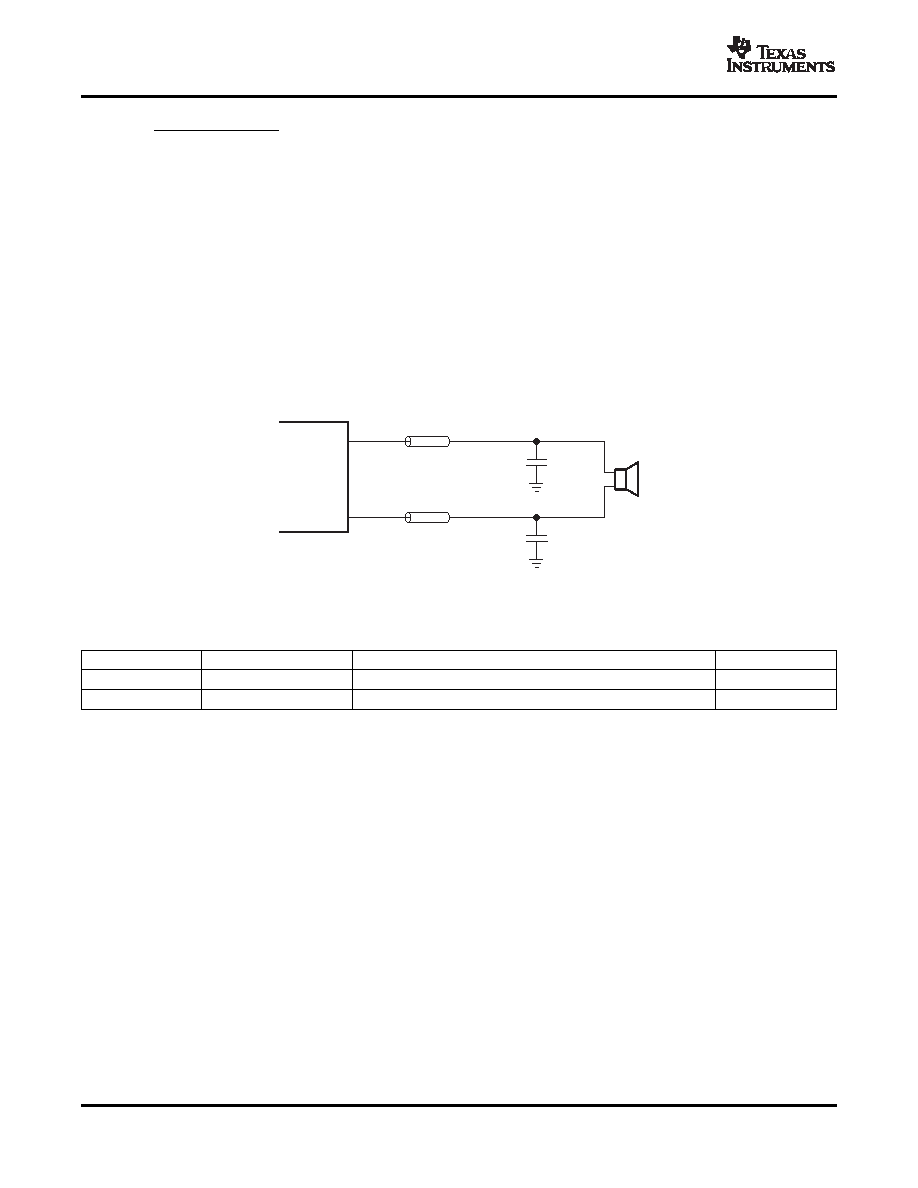- 您現(xiàn)在的位置:買賣IC網(wǎng) > PDF目錄98270 > TPA2013D1YZH (TEXAS INSTRUMENTS INC) 2.7 W, 2 CHANNEL, AUDIO AMPLIFIER, BGA16 PDF資料下載
參數(shù)資料
| 型號(hào): | TPA2013D1YZH |
| 廠商: | TEXAS INSTRUMENTS INC |
| 元件分類: | 音頻/視頻放大 |
| 英文描述: | 2.7 W, 2 CHANNEL, AUDIO AMPLIFIER, BGA16 |
| 封裝: | 2.275 X 2.275 MM, LEAD FREE, DSBGA-16 |
| 文件頁數(shù): | 10/30頁 |
| 文件大小: | 949K |
| 代理商: | TPA2013D1YZH |
第1頁第2頁第3頁第4頁第5頁第6頁第7頁第8頁第9頁當(dāng)前第10頁第11頁第12頁第13頁第14頁第15頁第16頁第17頁第18頁第19頁第20頁第21頁第22頁第23頁第24頁第25頁第26頁第27頁第28頁第29頁第30頁

www.ti.com
I
)
I
1
C =
(2
f
R
c
p
(7)
FILTER FREE OPERATION AND FERRITE BEAD FILTERS
1nF
Ferrite
ChipBead
OUTP
OUTN
1nF
Ferrite
ChipBead
OPERATION WITH DACs AND CODECs
STEREO OPERATION APPLICATION
SLOS520 – AUGUST 2007
Any mismatch in capacitance between the two inputs inputs will cause a mismatch in the corner frequencies.
Choose capacitors with a tolerance of ±10% or better.
A ferrite bead filter can often be used if the design is failing radiated emissions without an LC filter and the
frequency sensitive circuit is greater than 1 MHz. This filter functions well for circuits that just have to pass FCC
and CE because FCC and CE only test radiated emissions greater than 30 MHz. When choosing a ferrite bead,
choose one with high impedance at high frequencies, and very low impedance at low frequencies. In addition,
select a ferrite bead with adequate current rating to prevent distortion of the output signal.
Use an LC output filter if there are low frequency (< 1 MHz) EMI sensitive circuits and/or there are long leads
from amplifier to speaker.
Figure 31 shows a typical ferrite bead output filters.
Figure 31. Typical Ferrite Chip Bead Filter
Suggested Chip Ferrite Bead
Load
Vendor
Part Number
Size
8
Murata
BLM18EG121SN1
0603
4
TDK
MPZ2012S101A
0805
When using switching amplifiers with CODECs and DACs, sometimes there is an increase in the output noise
floor from the audio amplifier. This occurs when mixing of the output frequencies of the CODEC/DAC with the
switching frequencies of the audio amplifier input stage. The noise increase can be solved by placing a low-pass
filter between the CODEC/DAC and audio amplifier. This filters off the high frequencies that cause the problem
and allow proper performance.
The TPA2013D1 has a two pole low pass filter at the inputs. The cutoff frequency of the filter is set to
approximately 100kHz. The integrated low pass filter of the TPA2013D1 eliminates the need for additional
external filtering components. A properly designed additional low pass filter may be added without altering the
performance of the device.
Use the boost converter of the TPA2013D1 to supply the power for another audio amplifier when stereo
operation is required. Ensure the gains of the amplifiers match each other. This prevents one channel from
sounding louder than the other. Use Equation 1 through Equation 5 to determine R1, R2, boost inductor, and the
boost capacitor values. Figure 32 is an example schematic. The TPA2032D1 is a good choice for this
application; the gain is internally set to 2 V/V, the power supply is compatible with VCCOUT of the TPA2013D1,
and the output power of the TPA2032D1 is on par with the TPA2013D1.
18
Copyright 2007, Texas Instruments Incorporated
Product Folder Link(s): TPA2013D1
相關(guān)PDF資料 |
PDF描述 |
|---|---|
| TPA2013D1RGPR | 2.7 W, 2 CHANNEL, AUDIO AMPLIFIER, PQCC20 |
| TPA2013D1YZHR | 2.7 W, 2 CHANNEL, AUDIO AMPLIFIER, BGA16 |
| TPA2013D1RGP | 2.7 W, 2 CHANNEL, AUDIO AMPLIFIER, PQCC20 |
| TPA2013D1RGPT | 2.7 W, 2 CHANNEL, AUDIO AMPLIFIER, PQCC20 |
| TPA2013D1YZHT | 2.7 W, 1 CHANNEL, AUDIO AMPLIFIER, BGA16 |
相關(guān)代理商/技術(shù)參數(shù) |
參數(shù)描述 |
|---|---|
| TPA2013D1YZHR | 功能描述:音頻放大器 2.7W OUTPUT PWR MONO CLASS-D AUD AMP RoHS:否 制造商:STMicroelectronics 產(chǎn)品:General Purpose Audio Amplifiers 輸出類型:Digital 輸出功率: THD + 噪聲: 工作電源電壓:3.3 V 電源電流: 最大功率耗散: 最大工作溫度: 安裝風(fēng)格:SMD/SMT 封裝 / 箱體:TQFP-64 封裝:Reel |
| TPA2013D1YZHT | 制造商:Texas Instruments 功能描述:AUD AMP SPKR 1CH MONO 2.7W CLS-D 16DSBGA - Tape and Reel |
| TPA2014D1 | 制造商:TI 功能描述:1.5-W CONSTANT OUTPUT POWER CLASS-D AUDIO AMPLIFIER WITH INTEGRATED BOOST CONVERTER |
| TPA2014D1_0806 | 制造商:TI 制造商全稱:Texas Instruments 功能描述:1.5-W CONSTANT OUTPUT POWER CLASS-D AUDIO AMPLIFIER WITH INTEGRATED BOOST CONVERTER |
| TPA2014D1EVM | 功能描述:音頻 IC 開發(fā)工具 TPA2014D1EVM Eval Mod RoHS:否 制造商:Texas Instruments 產(chǎn)品:Evaluation Kits 類型:Audio Amplifiers 工具用于評(píng)估:TAS5614L 工作電源電壓:12 V to 38 V |
發(fā)布緊急采購,3分鐘左右您將得到回復(fù)。